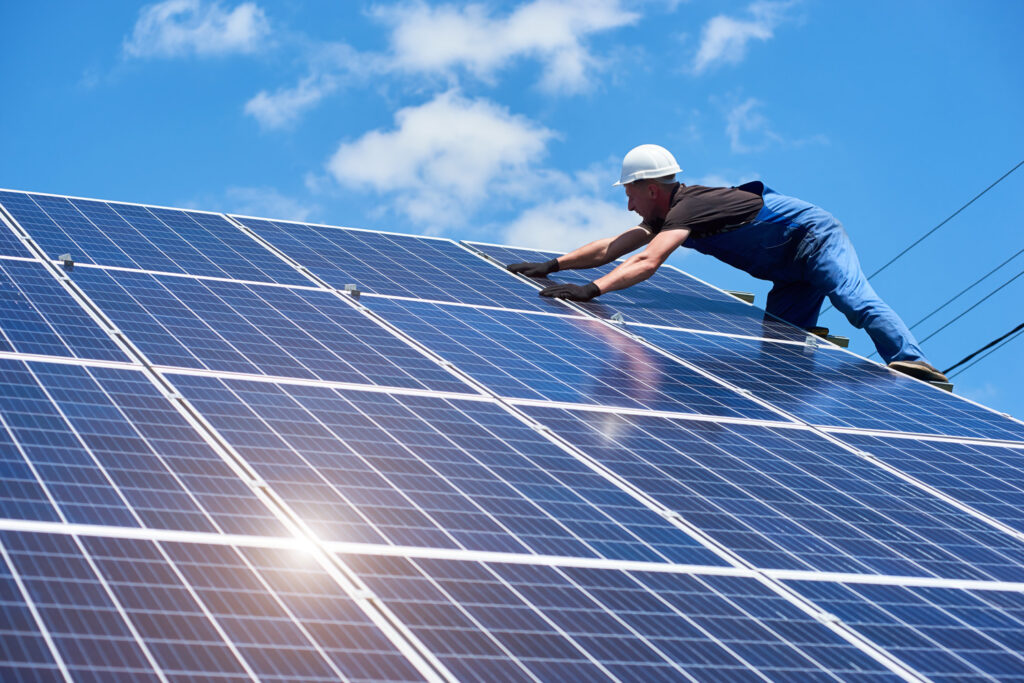
Installing Solar Panels on Flat Roofs vs. Sloped Roofs
Solar energy continues to grow in popularity for both homeowners and businesses, and you’ve likely seen solar panels on roofs of all types. But how does the shape of the roof impact the installation of the solar panels? Is one type of installation more difficult and more costly than another? Both flat and sloped roofs present their own unique advantages and challenges when it comes to installing solar panels. Keep reading to learn more about the key differences between installing solar panels on flat roofs and sloped roofs, including how the roof’s slope (or lack thereof) can impact performance.
Roof Design and Mounting Requirements
Flat roofs are primarily found on commercial buildings, but some modern residential homes feature this type of roof design as well. They offer the benefit of a flexible panel layout, since there aren’t any predefined angles that will impact the direction the panels face. However, because flat roofs don’t naturally face the sun, solar panels on a flat roof need to be installed on an angled racking system to improve their sun exposure.
These types of racking systems are usually tilted between 10 and 30 degrees, depending on your location. Ballasted mounting systems are often used on flat roofs; this type of racking doesn’t require any roof penetration, and instead relies on heavily weighted supports to hold the panels in place. This helps preserve your roof, especially on commercial buildings that may have rubber or built-up roofing, reducing concerns regarding installation-related leaks.
Sloped roofs are more common on your average residential home. This roof type already has varying angles built in (with the exact number of slopes varying based on your roof’s design). These slopes can be extremely beneficial—assuming they’re sloped in the right direction. Panels are typically mounted on a much smaller racking system that lies flush with the roof’s slope, while leaving room for ventilation beneath the panel. The rails are attached to the rafters or decking below the roofing material for stability.
Installing on sloped roofs requires careful consideration of the roof’s pitch, orientation, and any existing shading. Penetrating the roofing material is also usually required to secure the mounting hardware; however, installers reseal these penetrations so that there is minimal risk of any leaking.
Sun Exposure and Energy Efficiency
One of the biggest advantages of flat roofs is that you can position solar panels at the ideal angle and direction for maximum solar exposure, rather than accepting the roof’s existing slope as the angle of installation. Installers can arrange the panels to face true south (for buildings in the northern hemisphere) and adjust the tilt to the ideal angle to match your latitude and capture the most sunlight. This flexibility can maximize your solar production year-round.
Sloped roofs are less flexible with panel orientation. If your slope faces south (in the northern hemisphere), the system will perform very well with minimal adjustments to angle or design. However, if the slope faces any other direction, it can compromise the performance of your panels, or require additional racking or supplemental panels on another slope to meet your needs. While tilt can be customized a little bit with special mounting brackets, installers are usually pretty limited by the roof’s existing slope, which is not always ideal for energy generation.
Installation Time and Complexity
While flat roofs offer flexibility in your panel installation, they usually also require more planning, labor, and materials. The need for racking systems, ballasts, and more careful spacing to prevent shading from other panels increases the amount of time needed for installation. Installers also need to account for roof drainage systems and ensure the panels don’t block water flow or impede roof access for maintenance purposes.
Because the ballasted systems are much heavier than racking systems used on sloped roofs, a structural engineer usually needs to assess whether the roof can support the extra load. If ballasts can’t be used and the installation requires roof penetration, installers need to take extra care to avoid damaging the waterproof membranes in the roof.
Sloped roofs are more typical for these types of installations, and installers are more familiar with the mounting techniques used for this type of roof. The flush-mounted systems used on sloped roofs are relatively quick to install and need fewer components than flat-roof installations. However, the installers may need more safety equipment—like harnesses and roof anchors—since they are working on a sloped surface.
Cost Considerations
This goes hand in hand with some of the factors mentioned above, like installation complexity and equipment requirements. Simply put, flat-roof systems tend to cost more because of the need for additional mounting equipment, structural assessments, and ballast materials. These more complex systems simply require more time and effort to install, and that adds up in overall project expenses.
Sloped-roof installations are much simpler and much more familiar to installers. Because of this—and the need for less specialized equipment—you’ll usually pay less to install solar panels on a sloped roof. When examining what Mission Solar panels cost, always remember to take the complexity and cost of installation and labor into consideration as well to get a more accurate estimate of the cost of your system.
Popular Categories



